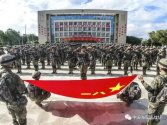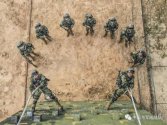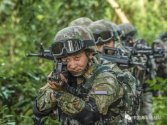You are using an out of date browser. It may not display this or other websites correctly.
You should upgrade or use an alternative browser.
You should upgrade or use an alternative browser.
Infantry Combat Equipment (non-firearm): Vests, Body Armor, NVGs, etc.
- Thread starter by78
- Start date
So what are the significant changes between the type19 gear and the new type 21? The type 19 already seemed modern enough.New type 21 boots close up and tutorial. Funny enough, the comment section on the original video had some troops who were watching because, and I quote "My type 21 commander did not teach us how to wear these so I'm here".
The soldiers said it was more comfortable and didn't rub the top of the foot which caused pain if used for long periods of time.So what are the significant changes between the type19 gear and the new type 21? The type 19 already seemed modern enough.
Does anyone know a good site for buying PLA gear? (UK here)
Frankly speaking, this is not the proper thread or even forum to ask such a question. However, I sent you a message about it.Does anyone know a good site for buying PLA gear? (UK here)
plawolf
Lieutenant General
The PLA apparently uses either digital night vision or a thermal monocular.
View attachment 94277View attachment 94278
Pics from @Nickatgreat1220 on twitter.
As for why, see Bltizo's comment. There exists a commercial demand for thermal cameras which China fulfills with companies like Guideir, Hikvision and Infiray. Aside from NVGs, there are few demands for image intensifier tubes.
Thermographic cameras are unable to see through the glass of scopes* (due to what wavelengths the thermals can see) so the PLA also issues out thermal sights (QBZ-191 service rifle family).
*Some thermographic cameras can see through glass but usually not the ones in thermal weapons sights which is why they are mounted in front of the scopes/sights being used.
I think the unit the PLA uses is digital. This seems to be the closest commercial version I have seen available.
Generally, consensus is that is surprisingly good, and falls between Gen1 and Gen2 for about 1/10th the cost of a Gen2 unit.
I would expect the one adopted by the PLA to be better than the commercially available units, and probably equivalent to Gen2 tubed night vision, which is really decent. Price wise I would also expect it to be a step up, maybe between $500-1000 per unit, which is still 1/4 to 1/2 the cost of tubes.
Cross posting this from the artillery section since these pics show that the marines are finally switching uniforms.Newest PCL181 operator, PLAN MC, probably 4th Brigade
View attachment 95282
View attachment 95283
View attachment 95284
View attachment 95285
View attachment 95286
View attachment 95287
MwRYum
Major
New BDU, new helmet, old flak jacket...at least the smurf camo is finally history.Cross posting this from the artillery section since these pics show that the marines are finally switching uniforms.
by78
General
Again some images of the new battlefield management system for individual soldiers. The first image shows more of the interface of the smart terminal. Specifically, an operator can view video feeds taken by the helmet mounted multi-functional cameras of his fellow soldiers. The operator can also record the video feeds and take screen shots. The network appears to be ad hoc (自组网). The interface has a connection speed indicator (300kbps), and the software version number is on the bottom (V1.00.01).









